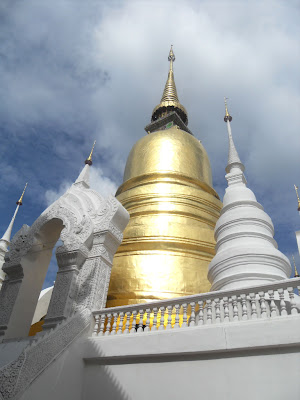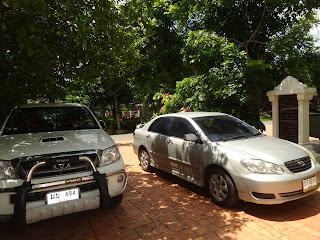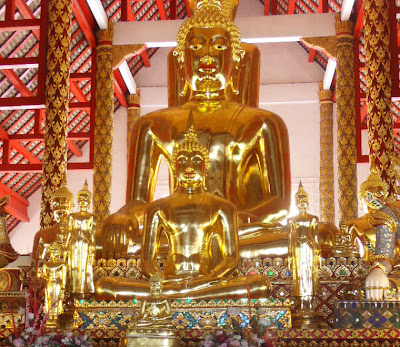 |
| วัดสวนดอก |
 |
| Maha Chula |
งานแสดงมุทิตาจิต พุทธศาสตร์บัณฑิต รุ่นที่56 อารามหลวงวัดสวนดอก 28 พค. 2011





















|
|
For many years I observed and studied the symbolic significances of famous Buddha statues. The statues were made with various valuable, often priceless materials and an array of techniques. It is not surprising that many Thai professional artists are keenly interested to paint pictures about Buddhism or sculpt the Buddha statues. Someone once said that there is at least one temple in every kilometer of Chiang Mai city and there are more than 30 famous temples including "Wat Chedi Luang" and "Wat Phra Singh" behind the wall of the old city. An interesting aspect of the Northern 'Buddha' art form is that people usually stare at the lips of large Buddha statues which are in standing, meditating, lying and in other positions. Many want to know why the lips of Buddha statues were painted red. The answer is simply that the red lips of Buddha statues in the Northern style were strongly influenced by Burmese art.
เป็นเวลาหลายปีที่ดิฉันได้สังเกตและศึกษาเรื่องความสัมพันธ์ทางสัญลักษณ์ของพระพุทธรูปที่มีชื่อเสียง พระพุทธรูปถูกจัดสร้างด้วยของมีค่าหลายชนิดซึ่งบางอย่างประเมินค่าไม่ได้และใช้เทคนิคที่แตกต่างกัน จึงไม่น่าที่จะประหลาดใจเลยว่าศิลปินมืออาชีพชาวไทยสนใจในการวาดภาพเกี่ยวกับศาสนาหรือการ
ปั้นพระพุทธรูป มีคนเคยกล่าวเอาไว้ว่าจะมีวัดอย่างน้อย 1 แห่งทุกๆกิโลเมตรของจังหวัดเชียงใหม่และมีวัดมากกว่า 30 แห่งรวมทั้งวัดพระสิงห์และวัดเจดีย์หลวงอยู่หลังกำแพงเมืองเก่า อีกหนึ่งมุมมองที่น่าสนใจของรูปแบบศิลปะพระพุทธรูปทางเหนือ ผู้คนมักจะจ้องมองริมฝีปากพระพุทธรูปขนาดใหญ่ในปาง
ประทับยืน ปางสมาธิ ปางไสยาสน์หรือปางอื่นๆ หลายคนอยากทราบว่าทำไมริมฝีปากของพระพุทธรูปถึงทาด้วยสีแดง คำตอบคือริมฝีปากของพระพุทธรูปทางเหนือนั้นได้รับอิทธิพลมาจากศิลปะของพม่ามาอย่างมาก
|
 |
|

 |
Chiang Mai residents and visitors who come to Chiang Mai are eager to find the most beautiful Buddha statues in the city. This is a matter of personal opinion but I will show you two main Buddha statues that I like the most. These two statues were placed in two educational institutes in Chiang Mai. The first one is called "Pra Chao Kaw Tue" which was in the area of Wat Suandok Chiang Mai, the location of the university for monks "Mahachulalongkorn rajawittayalai" Chiang Mai campus.
|

 |
|
This large Buddha statue was made from molten iron and weighs about nine tons ('Tue' is a Lanna language word that means a weight of about 1,000 kilograms). In the past, this Buddha statue was highly praised to be the most beautiful statue in Lanna. In the present, that praise is still unchanged. The statue was made in Chiang Saen style by Lanna and Sukhothai sculptors. Phaya Muang Kaew, the 13th King of Mengrai dynasty ordered the building of this statue in 1484 to be the main Buddha statue of Wat Pra Singh, but the size was too large and too difficult to move. So he gave his royal house to cover the statue and changed it to be a temple instead and gave the new name of the temple "Wat Kaw Tue" which is consistent with the statue. The lap width of the statue is about 3 meters and the height is about 4.70 meters.
พระพุทธรูปขนาดใหญ่สร้างมาจากโลหะหลอมเหลวและมีน้ำหนักประมาณ9 ตัน (ตื้อเป็นภาษาล้านนามีความหมายถึงน้ำหนักประมาณ 1000 กิโลกรัม)ในอดีตกาลพระพุทธรูปองค์นี้ได้รับคำชื่นชมเป็นอย่างสูงว่าเป็นพระพุทธรูปที่สวย ที่สุดของล้านนา ในปัจจุบันคำชื่นชมนั้นก็ยังไม่เปลี่ยนแปลง เป็น
พระพุทธรูปแบบเชียงแสนจัดทำโดยช่างฝีมือชาวล้านนาและสุโขทัยพญาเมืองแก้วกษัตริย์องค์ที่ 13 แห่งราชวงค์เม็งรายทรงมีพระราชโองการให้ก่อสร้างพระพุทธรูปองค์นี้ในปีพ.ศ. 2027 ให้เป็นพระพุทธรูปองค์ประธานของวัดพระสิงห์ แต่เนื่องจากว่ามีขนาดใหญ่โตมากเกินไปและเคลื่อนย้ายไม่สะดวก
พระองค์จึงพระราชทานวังส่วนพระองค์เพื่อสร้างครอบพระพุทธรูปและเปลี่ยนชื่อใหม่เป็น "วัดเก้าตื้อ" ให้สอดคล้องกับองค์พระพุทธรูป พระพุทธรูปมีขนาดหน้าตักกว้าง ประมาณ 3 เมตรและมีความสูง 4.70 เมตร


































































































No comments:
Post a Comment